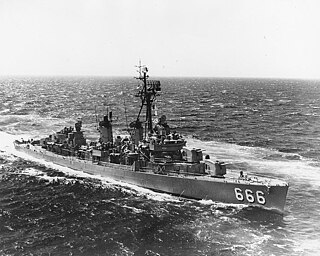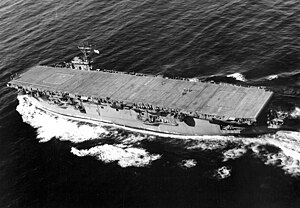
USS Rabaul was a Commencement Bay-class escort carrier of the United States Navy. The Commencement Bay class were built during World War II, and were an improvement over the earlier Sangamon class, which were converted from oil tankers. They were capable of carrying an air group of 33 planes and were armed with an anti-aircraft battery of 5 in (127 mm), 40 mm (1.6 in), and 20 mm (0.8 in) guns. The ships were capable of a top speed of 19 knots, and due to their origin as tankers, had extensive fuel storage. She was delivered on 30 August 1946, but never commissioned. After spending 26 years in reserve, she was scrapped in 1973.

USS Munda (CVE-104) was the last of fifty United States Navy Casablanca-class escort carrier built for service during World War II. She was named after the Battle of Munda Point, which occurred on the island New Georgia, a part of the Solomon Islands in 1943. The ship was launched in May 1944, and commissioned in July, and served as an aircraft transport and as a replenishment escort carrier in the Pacific Theatre. Postwar, she participated in Operation Magic Carpet, the repatriation of U.S. forces from bases scattered around the Pacific. She was decommissioned in April 1946, when she was mothballed in the Pacific Reserve Fleet. Ultimately, she was sold for scrapping in June 1960.

USS Card was an American Bogue-class escort carrier that saw service in World War II. She was named for Card Sound, a continuation of Biscayne Bay, south of Miami, Florida. She was the flagship of Task Group 21.14, a hunter-killer group formed to destroy German submarines in the North Atlantic.

USS Copahee (CVE-12) was a Bogue-class escort carrier that served in the United States Navy during World War II. Originally classified AVG-12, was changed to ACV-12, 20 August 1942; CVE-12, 15 July 1943; and CVHE-12, 12 June 1955.

USS Nassau (CVE-16) was laid down 27 November 1941 by the Seattle-Tacoma Shipbuilding Corporation of Tacoma, Washington, as M.C. Hull No. 234; launched 4 April 1942; sponsored by Mrs. G. H. Hasselman, Tongue Point, Oregon; acquired by the Navy 1 May, towed to the Puget Sound Navy Yard, Bremerton, Washington, and converted to an escort carrier; and commissioned 20 August, Captain Austin K. Doyle in command.

USS Barnes (AVG-20/ACV-20/CVE-20) was a Bogue-class escort carrier in the United States Navy. She was the second ship to carry the name.

The second USS Chenango (CVE-28) was launched on 1 April 1939 as Esso New Orleans by the Sun Shipbuilding and Dry Dock Company, in Chester, Pennsylvania, sponsored by Mrs. Rathbone; acquired by the United States Navy on 31 May 1941; and commissioned on 20 June 1941 as AO-31.

USS St. Simon (CVE-51), an escort aircraft carrier originally classified as an auxiliary aircraft carrier, was laid down on 26 April 1943 at Tacoma, Washington, by the Seattle-Tacoma Shipbuilding Corporation, under a Maritime Commission contract ; reclassified as an escort aircraft carrier, CVE-51, on 15 July 1943; launched on 9 September 1943; sponsored by Mrs. R. H. Lewis, the wife of Major General R. H. Lewis, Commanding General, Northwestern Sector, Fort Lewis, Washington; assigned to the Commercial Iron Works, Portland, Oregon, for the completion of construction; and delivered to the Royal Navy, under lend-lease, on 31 December 1943.

USS Tinian was a Commencement Bay-class escort carrier of the United States Navy. The Commencement Bay class were built during World War II, and were an improvement over the earlier Sangamon class, which were converted from oil tankers. They were capable of carrying an air group of 33 planes and were armed with an anti-aircraft battery of 5 in (127 mm), 40 mm (1.6 in), and 20 mm (0.8 in) guns. The ships were capable of a top speed of 19 knots, and due to their origin as tankers, had extensive fuel storage.

USS Sicily was a Commencement Bay-class escort carrier in the United States Navy. The Commencement Bay class were built during World War II, and were an improvement over the earlier Sangamon class, which were converted from oil tankers. They were capable of carrying an air group of 33 planes and were armed with an anti-aircraft battery of 5 in (127 mm), 40 mm (1.6 in), and 20 mm (0.8 in) guns. The ships were capable of a top speed of 19 knots, and due to their origin as tankers, had extensive fuel storage.

USS Thetis Bay (CVE-90) was the thirty-sixth of fifty Casablanca-class escort carriers built for the United States Navy during World War II. She was launched in March 1944, commissioned in April, and served as a transport carrier in the Pacific, as well as a replenishment carrier supporting the Allied bombardment of Tokyo and the Main Islands. Postwar, she participated in Operation Magic Carpet, before being decommissioned in August 1946, being mothballed in the Pacific Reserve Fleet. She was reactivated in July 1956, and converted to a helicopter transport carrier, serving in relief operations in Taiwan and Haiti. Ultimately, she was broken up in 1966, the last Casablanca-class hull to be scrapped.

USS Sitkoh Bay (CVE-86) was the thirty-second of fifty Casablanca-class escort carriers built for the United States Navy during World War II. She was named after Sitkoh Bay, located within Chichagof Island, of the Territory of Alaska. The ship was launched in February 1944, commissioned in March, and served as a replenishment and transport carrier throughout the Philippines campaign, the Invasion of Iwo Jima and the Battle of Okinawa. She was decommissioned in November 1946, when she was mothballed in the Atlantic Reserve Fleet. With the outbreak of the Korean War, however, she was called back to service, continuing to serve as a transport and utility carrier with the Military Sealift Command until 1954, when she was once again decommissioned, and mothballed in the Pacific Reserve Fleet. Ultimately, she was broken up in January 1961.

USS Savo Island (CVE-78) was the twenty-fourth of fifty Casablanca-class escort carriers built for the United States Navy during World War II. She was named to memorialize the U.S. casualties of the Battle of Savo Island, which was fought as part of the Guadalcanal campaign. The ship was launched in December 1943, commissioned in February 1944, and served as a frontline carrier throughout the Mariana and Palau Islands campaign and the Philippines campaign. During the Battle of Okinawa, she provided air cover for the replenishment carrier fleet. Postwar, she participated in Operation Magic Carpet, repatriating U.S. servicemen from throughout the Pacific. She was decommissioned in December 1946, when she was mothballed in the Atlantic Reserve Fleet. Ultimately, she was sold for scrapping in February 1960.

USS John C. Butler (DE-339) was the lead ship of her class of destroyer escorts in the service with the United States Navy from 1944 to 1946. She was recommissioned between 1950 and 1957 and finally sunk as a target in 1971.

USS Haraden (DD-585), a Fletcher-class destroyer, was the second ship of the United States Navy to be named for Jonathan Haraden (1744–1803), a privateer of the American Revolutionary War.

The fourth USS Preble (DD-345/DM-20/AG-99) was a United States Navy Clemson-class destroyerin commission from 1920 to 1945. She served in China, including on the Yangtze Patrol, and later saw combat in World War II as a minelayer. She was named for Commodore Edward Preble.

USS Satterlee (DD-626) was a Gleaves-class destroyer in the United States Navy during World War II. She is the second Navy ship named for United States Coast Guard Captain Charles Satterlee.

USS Black (DD-666) was a Fletcher-class destroyer of the United States Navy.

USS Rooks (DD-804) was a Fletcher-class destroyer of the United States Navy, named for Captain Albert H. Rooks (1891–1942) who was posthumously awarded the Medal of Honor after the Battle of Sunda Strait.

USS Knudson (APD-101), ex-DE-591, later LPR-101, was a United States Navy high-speed transport in commission from 1944 to 1946 and from 1953 to 1958.




















